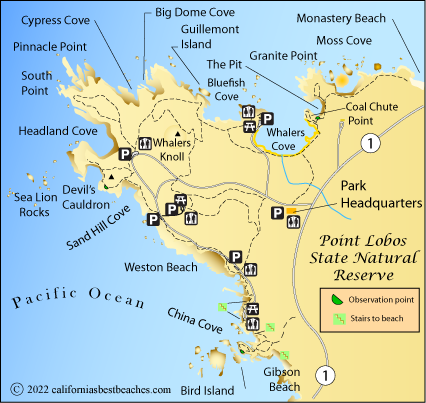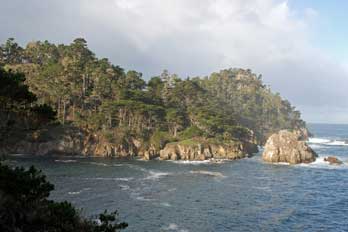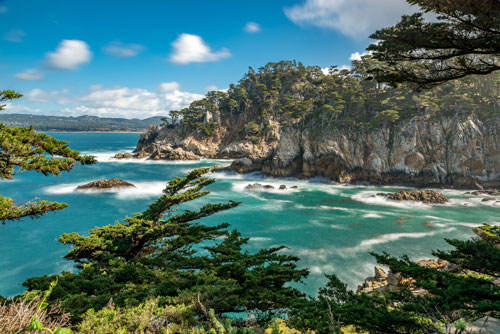Point Lobos State Natural Reserve
Point Lobos State Natural Reserve is an extravagant combination of rugged headlands, hidden coves, meadows, cypress and pine trees, and diverse wildlife just minutes south of Monterey. With over 200 different species of animals and 300 species of plants in one of the most spectacular settings on the west coast, Point Lobos is held up as California's premier coastal parkland.
Point Lobos State Natural Reserve consists of about 400 acres. In addition, there are about 750 underwater acres which are part of the Monterey Bay National Marine Sanctuary.

Visiting Point Lobos
The park is open year-round. During peak times in summer months, it can be so crowded that cars are held in a que until space becomes available. Parking is limited. Trails are numerous, winding across the meadows, up the slopes, and along the coast. In some places you can take stairs down to beaches. Swimming is permitted in some locations. Three picnic areas are spaced across the reserve.

Bluefish Cove
The Point Lobos Foundation
The Point Lobos Foundation was organized in 1978 as a charitable non-profit association to support interpretive and educational programs at Point Lobos State Natural Reserve. Their volunteers maintain interpretive collections, provide a research library, and publish materials about all aspects of the Reserve. For more about their wonderful work at Point Lobos, and for comprehensive information about Point Lobos Reserve, visit the Point Lobos Foundation website.
A Brief History
In the 1850s Chinese fishermen settled on Point Lobos, taking advantage of the abundant abalone along the coast. A cannery was built at Whalers Cove and was in operation until late in the 1920s.
Point Lobos was first used as a whaling station in the 1860s when Portuguese whalers set up a small community near Whalers Cove. For several decades whales were killed along the coast and brought to the cove for processing.
Coal was discovered in the nearby hills in the 1870s and carted to Coal Chute Point in Whalers Cove where it was sent down a chute to waiting steamships. The operation closed in the late 1890s. Granite taken from a quarry at Whalers Cove was used to build the United States Mint in San Francisco and other important structures. Gravel was harvested from The Pit, a cove near Coal Chute Point.
Point Lobos Land Mammals
While walking the trails through the meadows and forests of Point Lobos, you may encounter some of the land mammals that live in the area. Black-tailed Deer are a common sight, as are squirrels and rabbits. More secretive residents include bobcats, raccoons, coyotes, foxes, and skunks. Mountain lions are rare visitors to Point Lobos.
Flora
Among the most prominent trees in the Reserve are Monterey Cypress, Monterey Pine, and California Live Oak. Sticky Monkey-flowers bloom year-round, while the wild lilacs flower in winter. Close to the water the seaside daisy blooms from spring into fall.
Garrapata State Park
Five miles south of Point Lobos is Garrapata State Park, featuring scenic Soberanes Point and Garrapata Beach.


